Abstract
1. In standing subjects, an ankle-dorsiflexing perturbation of the supporting surface evokes a short-latency response (SLR) and a medium-latency response (MLR) to stretch in both soleus (Sol) and flexor digitorum brevis (FDB) muscles. The SLR is the counterpart of the monosynaptic reflex, whilst the MLR might be either mediated by Ia fibres, the delay being due to a long-loop central circuit, or by fibres of slower conduction velocity. Since small afferents are slowed more than large ones by low temperature, a greater latency increment for the MLR than the SLR induced by cooling of the limb would point to a peripheral origin of the MLR. 2. In nine subjects, one limb was cooled by circulating water in a tube wrapped around it for about 120 min. Perturbations were delivered to the same limb prior to and during cooling, and after rewarming. EMG was recorded by surface electrodes from the Sol and FDB muscles. 3. The mean increase in latency of MLRs was significantly greater than that of SLRs in both muscles. On average, the Sol SLR increased from 42.4 to 47.0 ms and the Sol MLR from 72.0 to 82.3 ms. The FDB SLR increased from 58.1 to 66.5 ms and the FDB MLR from 94.9 to 110.5 ms. The mean difference (MLR minus SLR) increased from 29.6 to 35.2 ms for Sol, and from 36.8 to 43.9 ms for FDB at the end of cooling. After 30 min of rewarming, the responses of both muscles recovered towards control values. 4. The greater latency increment of the MLRs than of the SLRs favours the hypothesis of a slower conduction velocity of the responsible afferent fibres. The most likely candidate fibres are the spindle group II afferents.
Full text
PDF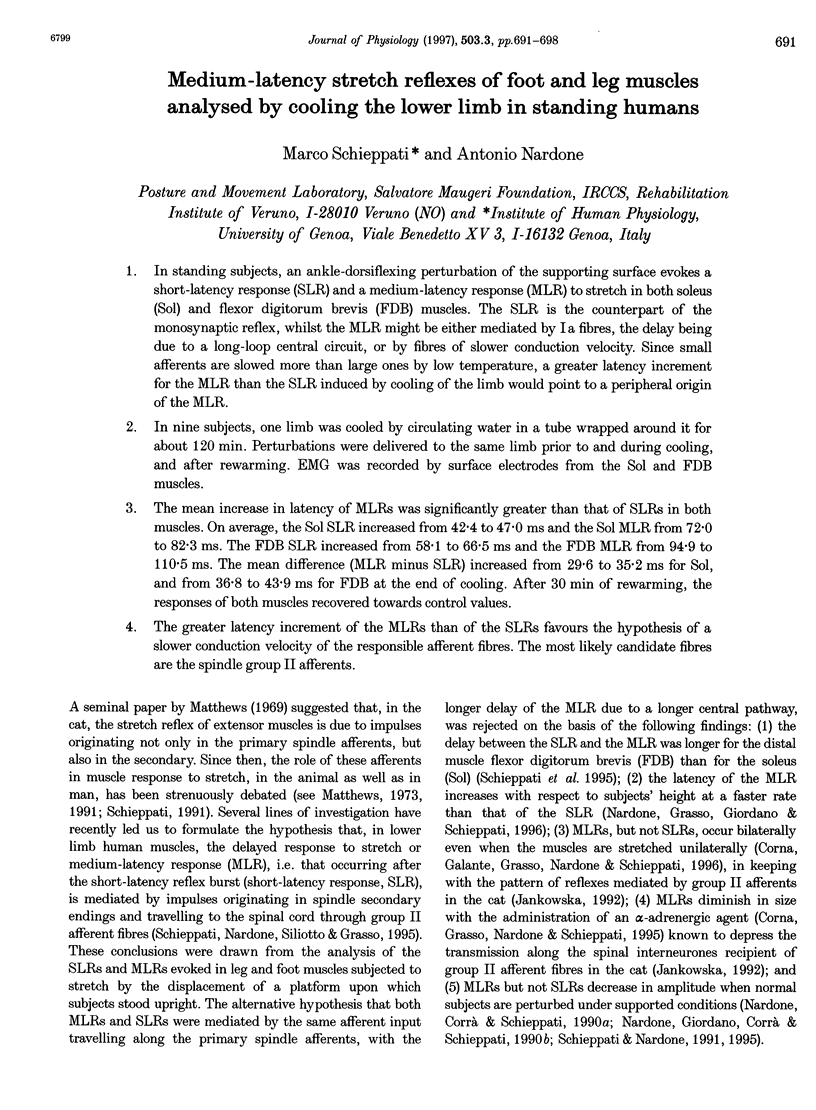
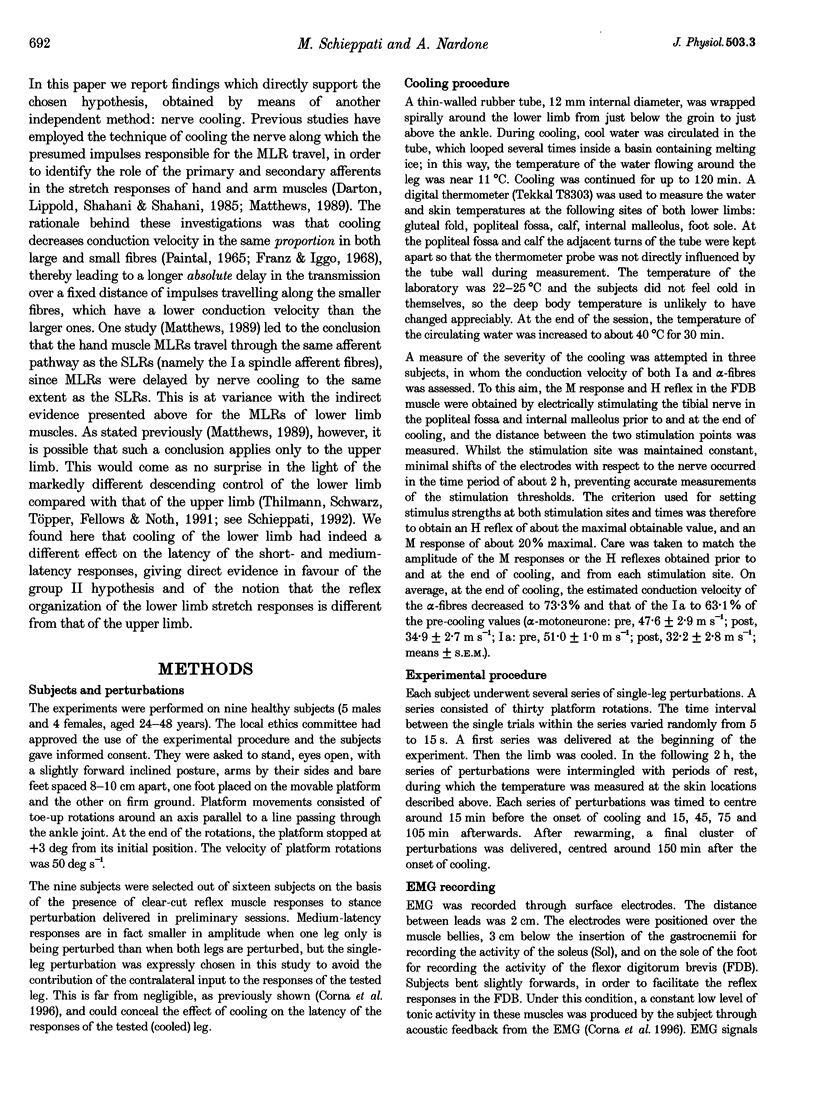
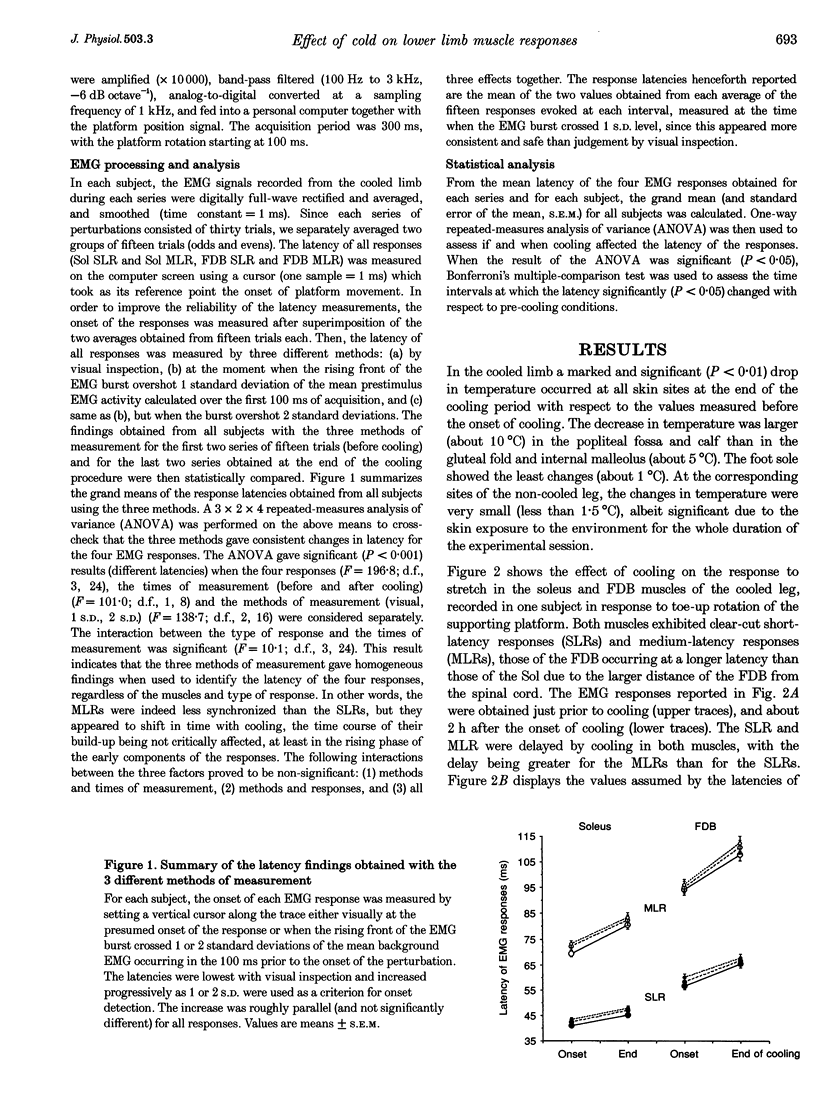

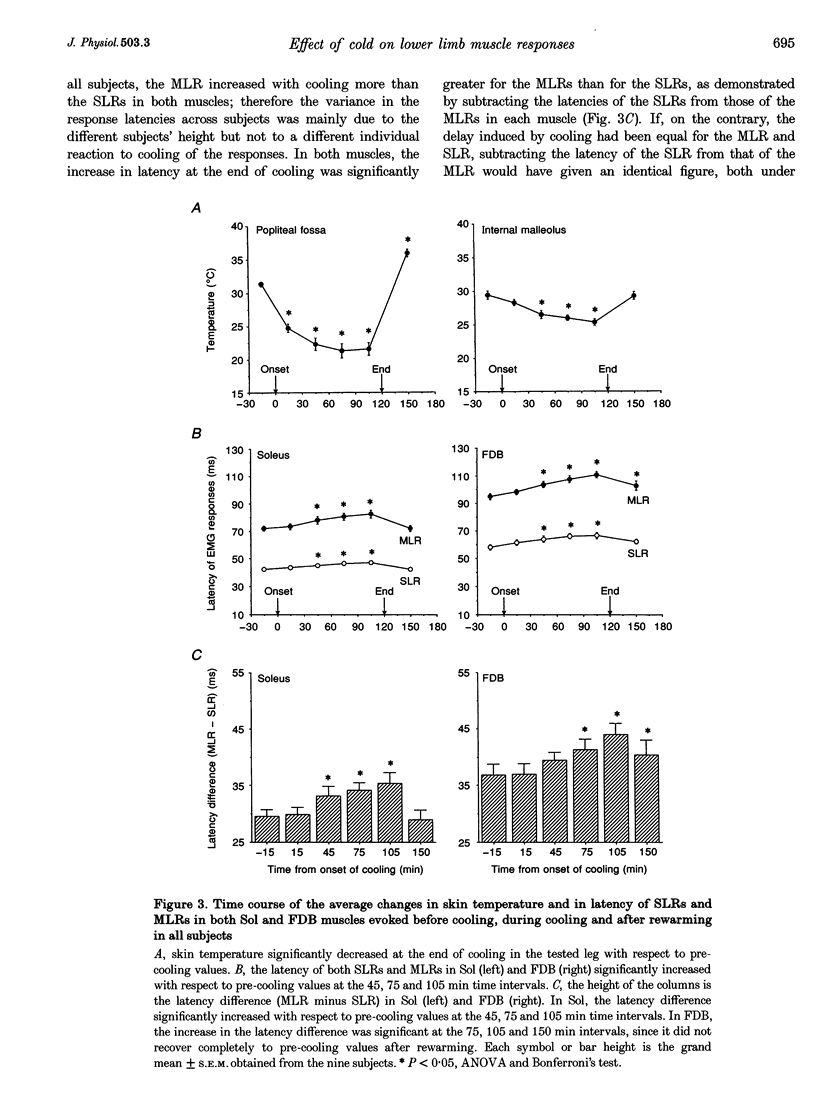

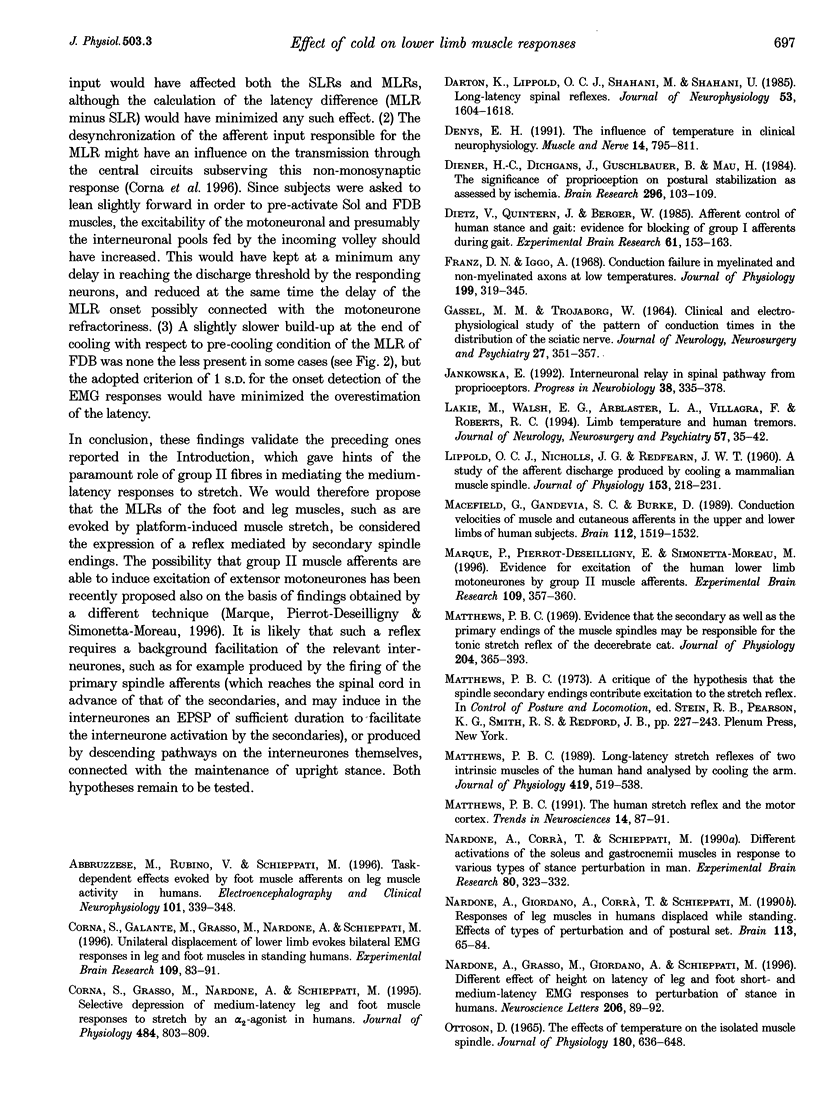
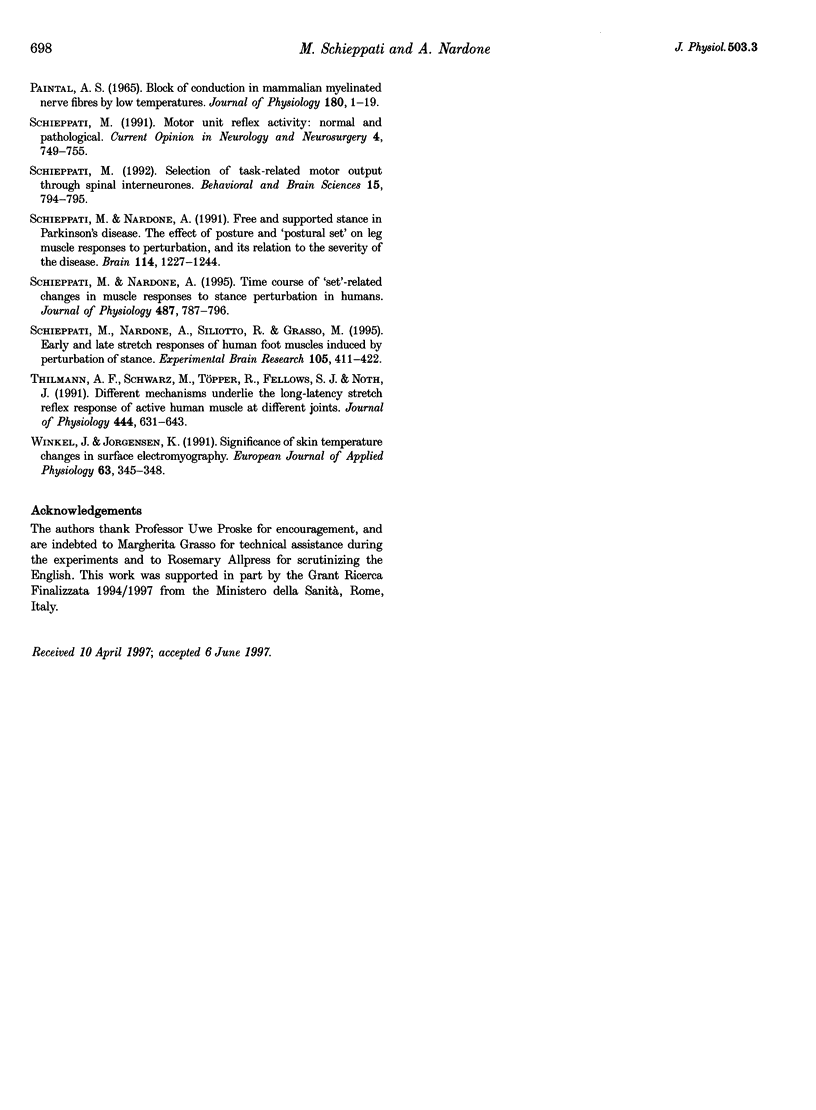
Selected References
These references are in PubMed. This may not be the complete list of references from this article.
- Abbruzzese M., Rubino V., Schieppati M. Task-dependent effects evoked by foot muscle afferents on leg muscle activity in humans. Electroencephalogr Clin Neurophysiol. 1996 Aug;101(4):339–348. doi: 10.1016/0924-980x(96)95682-9. [DOI] [PubMed] [Google Scholar]
- Corna S., Galante M., Grasso M., Nardone A., Schieppati M. Unilateral displacement of lower limb evokes bilateral EMG responses in leg and foot muscles in standing humans. Exp Brain Res. 1996 Apr;109(1):83–91. doi: 10.1007/BF00228629. [DOI] [PubMed] [Google Scholar]
- Corna S., Grasso M., Nardone A., Schieppati M. Selective depression of medium-latency leg and foot muscle responses to stretch by an alpha 2-agonist in humans. J Physiol. 1995 May 1;484(Pt 3):803–809. doi: 10.1113/jphysiol.1995.sp020705. [DOI] [PMC free article] [PubMed] [Google Scholar]
- Darton K., Lippold O. C., Shahani M., Shahani U. Long-latency spinal reflexes in humans. J Neurophysiol. 1985 Jun;53(6):1604–1618. doi: 10.1152/jn.1985.53.6.1604. [DOI] [PubMed] [Google Scholar]
- Denys E. H. AAEM minimonograph #14: The influence of temperature in clinical neurophysiology. Muscle Nerve. 1991 Sep;14(9):795–811. doi: 10.1002/mus.880140902. [DOI] [PubMed] [Google Scholar]
- Diener H. C., Dichgans J., Guschlbauer B., Mau H. The significance of proprioception on postural stabilization as assessed by ischemia. Brain Res. 1984 Mar 26;296(1):103–109. doi: 10.1016/0006-8993(84)90515-8. [DOI] [PubMed] [Google Scholar]
- Dietz V., Quintern J., Berger W. Afferent control of human stance and gait: evidence for blocking of group I afferents during gait. Exp Brain Res. 1985;61(1):153–163. doi: 10.1007/BF00235630. [DOI] [PubMed] [Google Scholar]
- Franz D. N., Iggo A. Conduction failure in myelinated and non-myelinated axons at low temperatures. J Physiol. 1968 Dec;199(2):319–345. doi: 10.1113/jphysiol.1968.sp008656. [DOI] [PMC free article] [PubMed] [Google Scholar]
- GASSEL M. M., TROJABORG W. CLINICAL AND ELECTROPHYSIOLOGICAL STUDY OF THE PATTERN OF CONDUCTION TIMES IN THE DISTRIBUTION OF THE SCIATIC NERVE. J Neurol Neurosurg Psychiatry. 1964 Aug;27:351–357. doi: 10.1136/jnnp.27.4.351. [DOI] [PMC free article] [PubMed] [Google Scholar]
- Jankowska E. Interneuronal relay in spinal pathways from proprioceptors. Prog Neurobiol. 1992;38(4):335–378. doi: 10.1016/0301-0082(92)90024-9. [DOI] [PubMed] [Google Scholar]
- LIPPOLD O. C., NICHOLLS J. G., REDFEARN J. W. A study of the afferent discharge produced by cooling a mammalian muscle spindle. J Physiol. 1960 Sep;153:218–231. doi: 10.1113/jphysiol.1960.sp006530. [DOI] [PMC free article] [PubMed] [Google Scholar]
- Lakie M., Walsh E. G., Arblaster L. A., Villagra F., Roberts R. C. Limb temperature and human tremors. J Neurol Neurosurg Psychiatry. 1994 Jan;57(1):35–42. doi: 10.1136/jnnp.57.1.35. [DOI] [PMC free article] [PubMed] [Google Scholar]
- Macefield G., Gandevia S. C., Burke D. Conduction velocities of muscle and cutaneous afferents in the upper and lower limbs of human subjects. Brain. 1989 Dec;112(Pt 6):1519–1532. doi: 10.1093/brain/112.6.1519. [DOI] [PubMed] [Google Scholar]
- Marque P., Pierrot-Deseilligny E., Simonetta-Moreau M. Evidence for excitation of the human lower limb motoneurones by group II muscle afferents. Exp Brain Res. 1996 May;109(2):357–360. doi: 10.1007/BF00231793. [DOI] [PubMed] [Google Scholar]
- Matthews P. B. Evidence that the secondary as well as the primary endings of the muscle spindles may be responsible for the tonic stretch reflex of the decerebrate cat. J Physiol. 1969 Oct;204(2):365–393. doi: 10.1113/jphysiol.1969.sp008918. [DOI] [PMC free article] [PubMed] [Google Scholar]
- Matthews P. B. Long-latency stretch reflexes of two intrinsic muscles of the human hand analysed by cooling the arm. J Physiol. 1989 Dec;419:519–538. doi: 10.1113/jphysiol.1989.sp017884. [DOI] [PMC free article] [PubMed] [Google Scholar]
- Matthews P. B. The human stretch reflex and the motor cortex. Trends Neurosci. 1991 Mar;14(3):87–91. doi: 10.1016/0166-2236(91)90064-2. [DOI] [PubMed] [Google Scholar]
- Nardone A., Corrà T., Schieppati M. Different activations of the soleus and gastrocnemii muscles in response to various types of stance perturbation in man. Exp Brain Res. 1990;80(2):323–332. doi: 10.1007/BF00228159. [DOI] [PubMed] [Google Scholar]
- Nardone A., Giordano A., Corrà T., Schieppati M. Responses of leg muscles in humans displaced while standing. Effects of types of perturbation and of postural set. Brain. 1990 Feb;113(Pt 1):65–84. doi: 10.1093/brain/113.1.65. [DOI] [PubMed] [Google Scholar]
- Nardone A., Grasso M., Giordano A., Schieppati M. Different effect of height on latency of leg and foot short- and medium- latency EMG responses to perturbation of stance in humans. Neurosci Lett. 1996 Mar 15;206(2-3):89–92. doi: 10.1016/s0304-3940(96)12430-7. [DOI] [PubMed] [Google Scholar]
- Ottoson D. The effects of temperature on the isolated muscle spindle. J Physiol. 1965 Oct;180(3):636–648. doi: 10.1113/jphysiol.1965.sp007721. [DOI] [PMC free article] [PubMed] [Google Scholar]
- Paintal A. S. Block of conduction in mammalian myelinated nerve fibres by low temperatures. J Physiol. 1965 Sep;180(1):1–19. [PMC free article] [PubMed] [Google Scholar]
- Schieppati M., Nardone A. Free and supported stance in Parkinson's disease. The effect of posture and 'postural set' on leg muscle responses to perturbation, and its relation to the severity of the disease. Brain. 1991 Jun;114(Pt 3):1227–1244. doi: 10.1093/brain/114.3.1227. [DOI] [PubMed] [Google Scholar]
- Schieppati M., Nardone A., Siliotto R., Grasso M. Early and late stretch responses of human foot muscles induced by perturbation of stance. Exp Brain Res. 1995;105(3):411–422. doi: 10.1007/BF00233041. [DOI] [PubMed] [Google Scholar]
- Schieppati M., Nardone A. Time course of 'set'-related changes in muscle responses to stance perturbation in humans. J Physiol. 1995 Sep 15;487(Pt 3):787–796. doi: 10.1113/jphysiol.1995.sp020918. [DOI] [PMC free article] [PubMed] [Google Scholar]
- Thilmann A. F., Schwarz M., Töpper R., Fellows S. J., Noth J. Different mechanisms underlie the long-latency stretch reflex response of active human muscle at different joints. J Physiol. 1991 Dec;444:631–643. doi: 10.1113/jphysiol.1991.sp018898. [DOI] [PMC free article] [PubMed] [Google Scholar]


